This Khaman Dhokla recipe makes a wonderfully soft and fluffy, lightly sweet, spiced and savory gram flour cake that’s perfect to enjoy anytime of the day. It’s easy to prepare, quick and instant Khaman recipe steamed on the stovetop or even in the Instant Pot with my step-by-step photos, video and instructions.
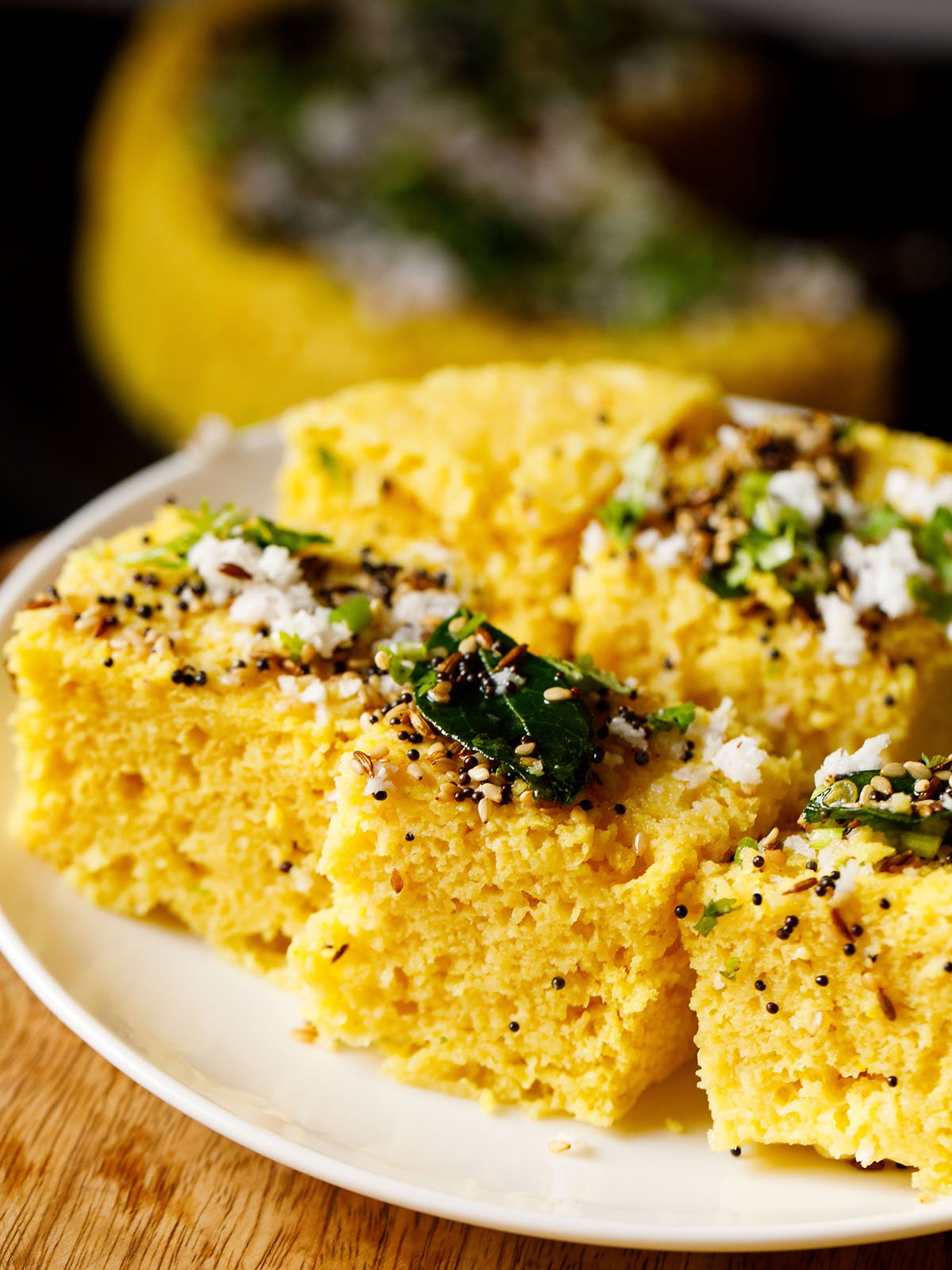
About Khaman Dhokla Recipe
Khaman, also known as Khaman Dhokla in other Indian states, is a popular delicacy from the Gujarati cuisine.
This popular light and spongy snack is made with a leavened batter of a spiced gram flour batter, that is later steamed in a pan. A tempering of spices and herbs is made which is then drizzled over this steamed cake.
This recipe makes a light, spongy dhokla and includes a hint of great savory flavor from a simple combination of gram flour (besan), spices, and herbs.
If you are wondering what is gram flour, it is simply is finely ground hulled black chickpeas. We also call it besan in Hindi.
Table of Contents
To leaven the batter instantly, there are a few ingredients you can use, that I have listed below. It is the reaction between the acidic lemon juice and the choice of leavening ingredient that aerates the batter, which helps in giving the Khaman its characteristic rise, softness and fluffiness.
Khaman is a healthy savory-sweet snack that happens to be vegan. Plus, it can be gluten-free too, if you skip semolina and asafoetida in the batter.
Khaman is also known as Yellow Dhokla as it has a yellow color or Besan Dhokla. It is also known as Instant Khaman.
I prepare Khaman Dhokla recipe with the steaming method either in an Instant pot or in a pan.
They’re perfect to enjoy for a hearty and satisfying breakfast or an afternoon or evening snack.
Dhokla vs Khaman
Khaman is popularly referred to as Khaman Dhokla but in actuality, a dhokla is made differently than khaman.
Dhokla is made with ground, fermented batter of rice and lentils like chana dal or urad dal. It is also called Vati Dal Dhokla in Gujarati.
While khaman recipe is made instantly with gram flour batter which is leavened by adding baking soda, citric acid or fruit salt. Khaman batter is not fermented unlike a dhokla batter.
The batter is leavened instantly using any of the leavening ingredients that you prefer. This leavened batter is then steamed in a greased pan like a steamed cake.
In the taste department, fermentation gives dhokla a really complex flavorsome taste, but a khaman also tastes equally great.
The color of dhokla can range from cream to light yellow or yellow but a khaman always has a bright yellow color.
Choice of Leavening Ingredients
To make soft and fluffy khaman dhokla you can choose between three leavening ingredients or a use a mix of two of them. Fruit salt, baking soda and citric acid are these ingredients and let us know more in detail about them.
1. Eno (Fruit Salt)
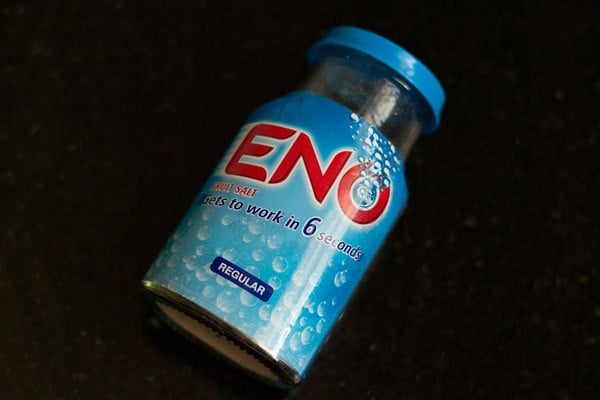
As a leavening agent, I use in this khaman recipe is fruit salt which results in a light and fluffy texture. Eno is a popular Indian brand of fruit salt that is used to relieve acidity and heartburn.
Fruit salt is composed of citric acid, sodium bicarbonate (baking soda), and sodium carbonate.
Sodium bicarbonate and sodium carbonate are effervescent ingredients that bubble and release carbon dioxide when added to water.
2. Baking Soda or Eno
To make khaman dhokla recipe, you can also use baking soda. But baking soda gives its soapy aroma if used in excess, so be careful not to add too much.
Eno gives you a perfect fluffy and soft khaman while the one made with baking soda is not that fluffy or spongy.
I personally prefer to use eno in khaman recipe as it gives the best results. I do not favor baking soda, as firstly we cannot stand the soapy aroma and secondly the texture is not that airy or spongy in comparison to the khaman dhokla recipe made with eno.
Use eno that is fresh and within its shelf period. If your eno is not fresh or active, the texture of khaman will be flat and dense. And please do not use flavored eno – the regular eno without any flavor works the best.
Both eno and baking soda react with turmeric powder and gives a red tinge or red spots in khaman dhokla. So add little turmeric powder or skip it completely.
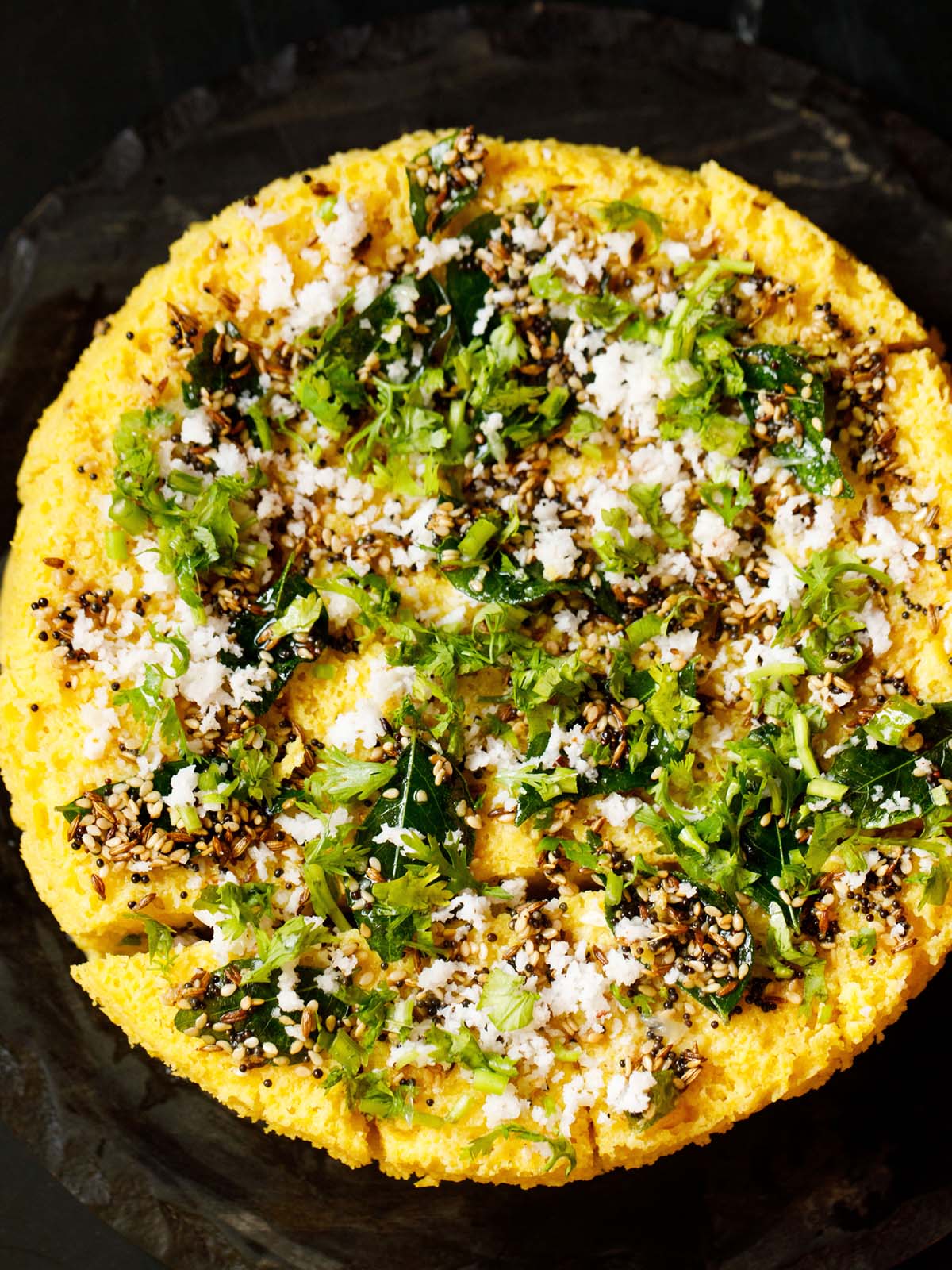
3. Lemon juice or Citric Acid
I have made khaman dhokla recipe both with lemon juice and citric acid. Citric acid gives a superb fluffy texture. Lemon juice also works great, but citric acid wins here. That said, use whatever is easily available to you.
To swap citric acid with lemon juice, use this standard proportion of:
1 tablespoon lemon juice = ¼ teaspoon citric acid (in the powdered form)
For citric acid, use a food-grade and pure citric acid. I also suggest including freshly squeezed lemon juice. Use a fresh lemon.
How to make Khaman Dhokla
Prep Pan
1. Grease a steamer pan with 2 to 3 teaspoons oil.
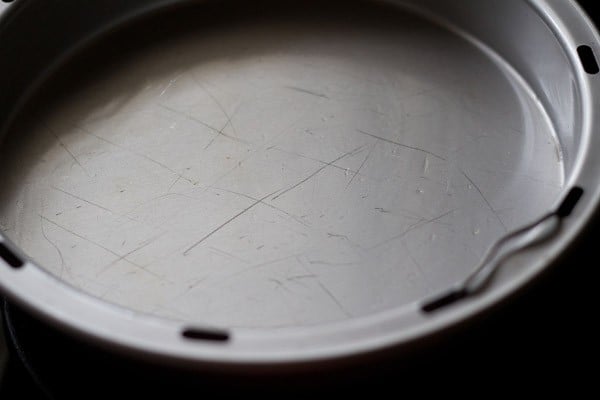
Make Batter
2. Take 1.5 cups gram flour (120 grams besan) in a mixing bowl or pan. Do use gram flour which has a fine texture.
Tip: You can make khaman with chickpea flour as well.
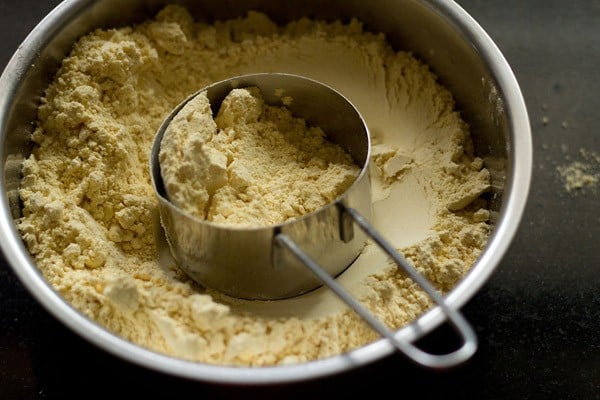
3. The add the following ingredients:
- 2 to 3 pinches of turmeric powder
- a generous pinch of asafoetida (skip to make a gluten-free version)
- 1.5 tablespoons lemon or lime juice or ⅓ to ½ teaspoon pure citric acid
- 1.5 teaspoons ginger paste (crush 1.5 inch ginger and 1.5 teaspoons green chilies in a mortar-pestle)
- 1.5 teaspoons green chili paste
- 1 tablespoon sugar or add according to taste
- 1 teaspoon salt or add as per taste
Tip: Avoid adding too much of turmeric powder as then the fruit salt or baking soda reacts with the turmeric powder and makes it red in color, thereby giving reddish dots, specks or tones in the khaman.
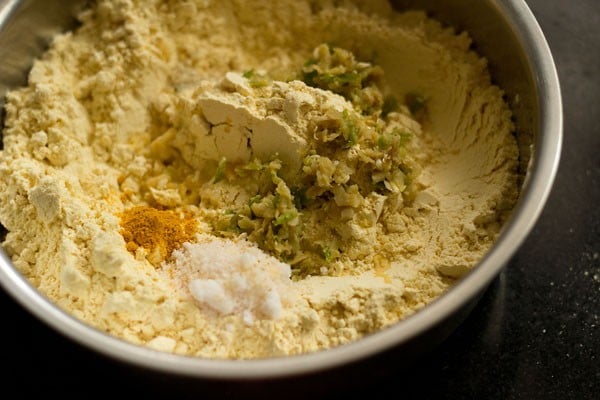
4. Add 1 cup water (or more or less as needed) and 1 tablespoon oil to make a thick yet smooth flowing batter.
The amount of water needed depends on the quality of flour, so start with 1 cup and add as required. Stir well to combine.
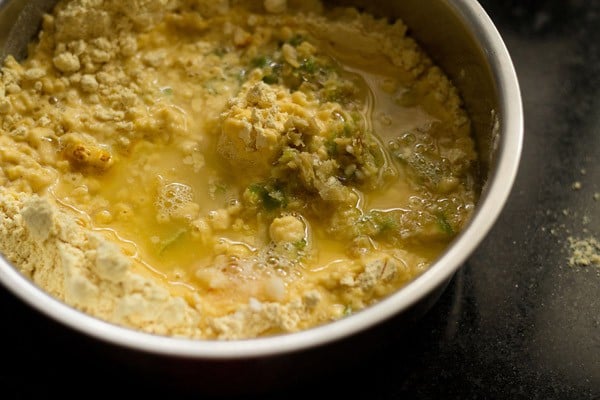
5. Then add 1 tablespoon rava (semolina). This is entirely optional but adds a good texture to the khaman. Skip rava or semolina for a gluten-free option.
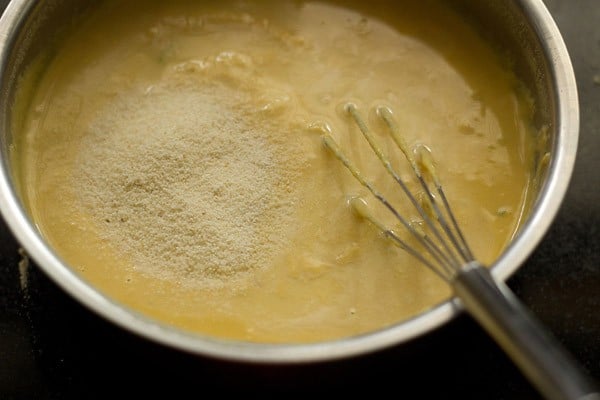
6. Stir with a whisk to create a smooth, thick batter without any lumps.
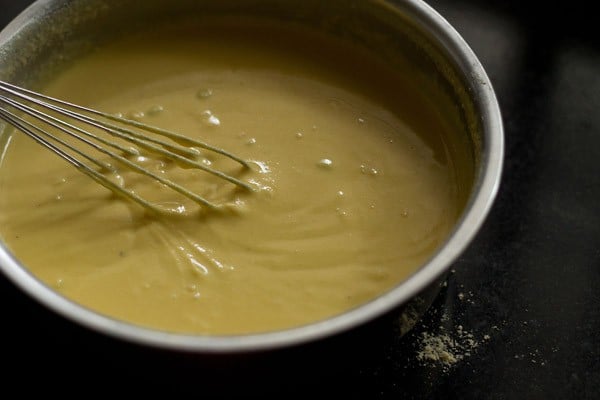
Batter Consistency
7. The batter should be thick yet flow easily off of the whisk. A quick tip is that if the batter becomes thin, then 1 to 2 tablespoons of gram flour.
Next bring 2 to 2.5 cups of water to a boil in a steamer pan or electric cooker or pressure cooker. The amount of water to be added depends on the size of the steamer or pressure cooker.
Note: To know more about the steaming in a pan, cooker and Instant Pot in detail, do read the tips section below.
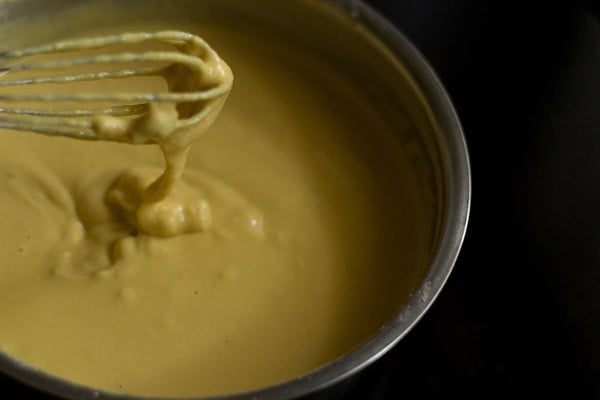
Leaven Batter
9. Next add 2 teaspoons Eno or fruit salt. 2 teaspoons of Eno makes the khaman soft and fluffy. But there is a slightly alkaline taste to Eno.
If you’re not a fan of this flavor then add only 1.5 teaspoons of Eno. If using baking soda as your leavening agent add ½ teaspoon to ¾ teaspoon.
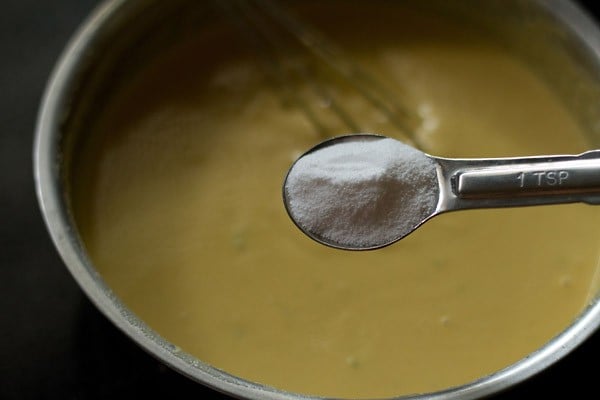
10. Stir and mix the eno with the batter briskly and quickly.
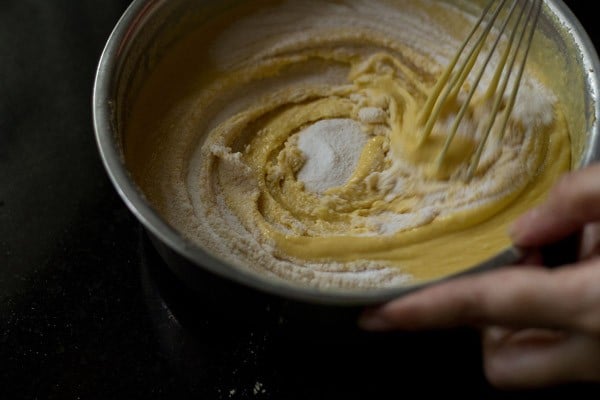
11. The fruit salt should be mixed evenly with the batter. Or else you get uneven texture in the khaman.
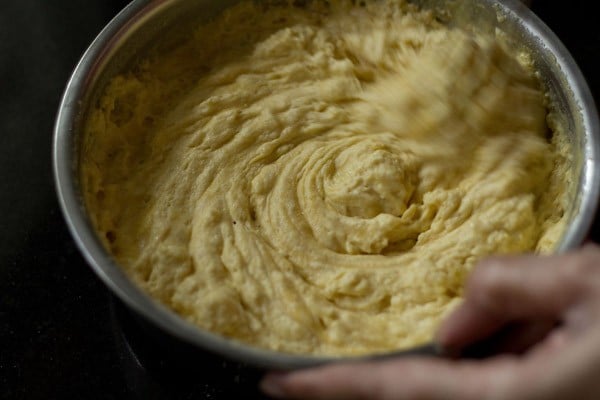
12. The eno will make the batter become frothy, so you need to work quickly to whisk it in thoroughly.
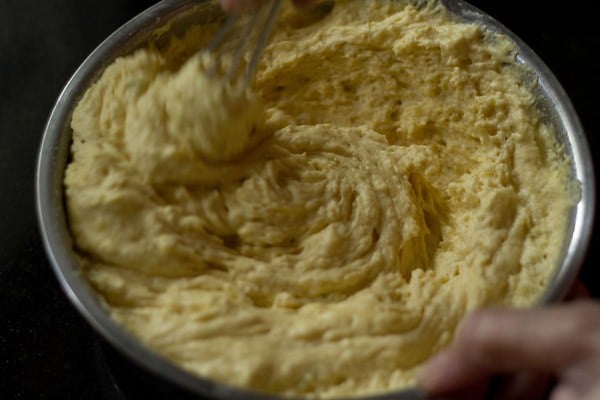
12. Pour the prepared batter into the greased pan.
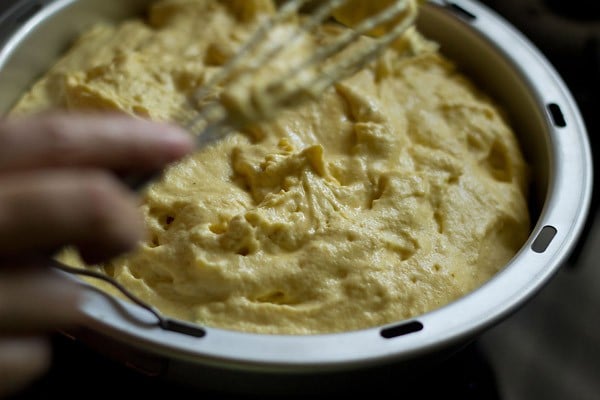
13. Gently shake so that the batter evens out in the pan. Below is a picture of the batter ready to be steamed.
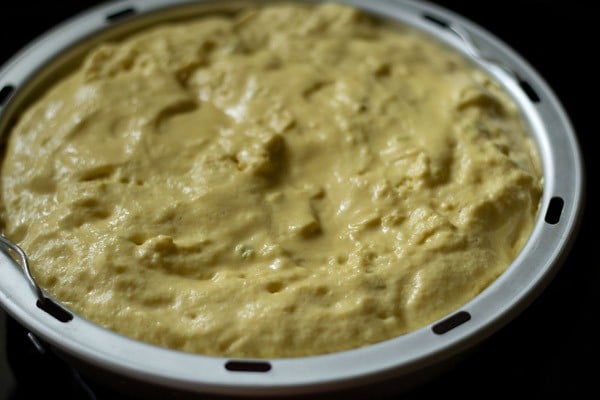
Steam
1. Place the pan in a steamer or electric rice cooker or pressure cooker. The water should already be boiling or hot when you place the pan with the khaman batter.
When using a pressure cooker, remove the vent weight/whistle from the lid and cover the cooker tightly with its lid.
Note: I have listed the detailed directions of steaming in a pan, pressure cooker and Instant pot in the tips sections below.
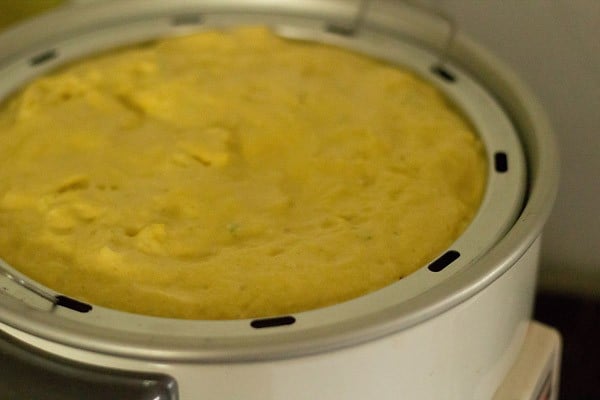
2. Steam for 15 to 20 minutes in an electric rice cooker. If using a pan or pressure cooker or Instant Pot, steam for 12 to 15 minutes on a medium to medium-high heat.
In the below photo the khaman is cooked for 17 minutes using an electric rice cooker.
You can begin working on the spice and herb solution for tempering the khaman while it cooks. Continue reading for the instructions.
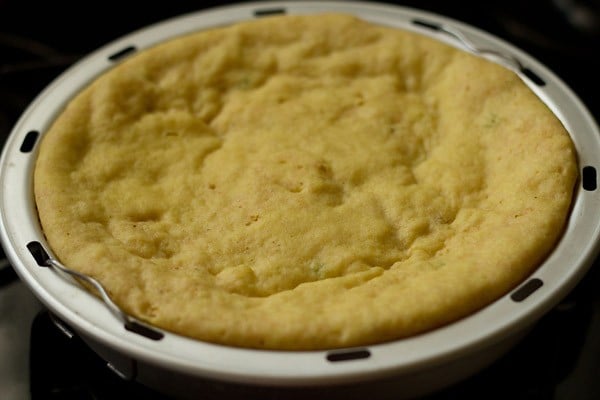
3. To check the doneness, insert a toothpick. It should come out clean if the khaman is done. If the toothpick has the batter on it, then you need to steam for another minutes or so.
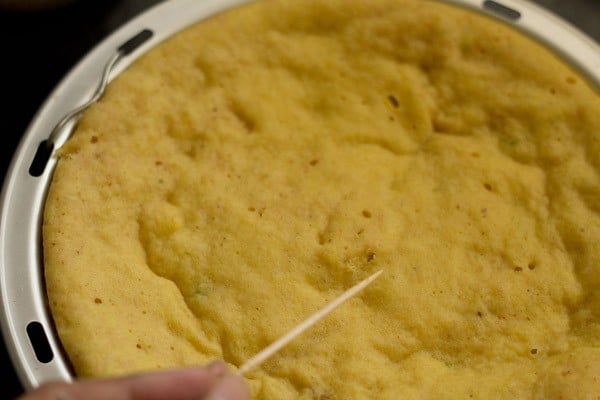
4. Let the khaman become warm or cool completely. Gently slide a butter knife along the edges to release the khaman from the pan. Place a plate or tray on top of the pan.
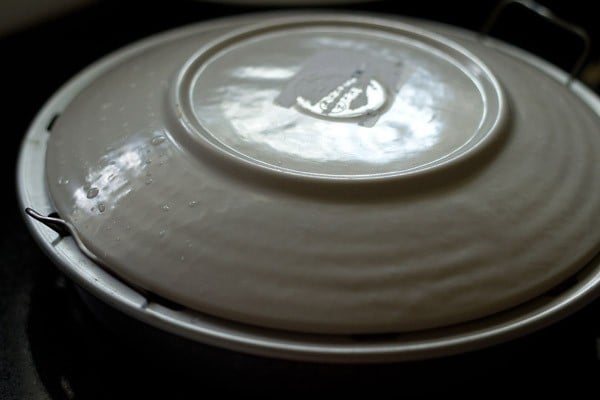
5. Then quickly invert the pan.
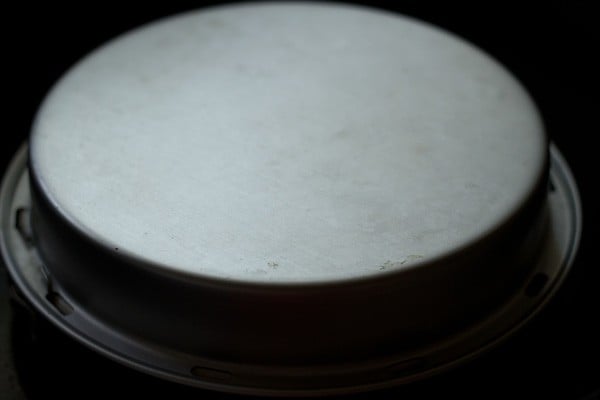
6. If greased well, the khaman will easily slide out onto the plate.
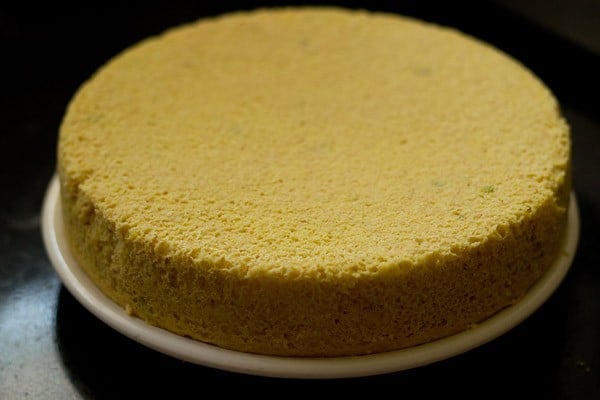
7. Use a sharp knife to slice the khaman in squares and set aside until ready to temper.
Since I used a concave plate, the khaman settled down in the center. This won’t happen if you use a flat plate.
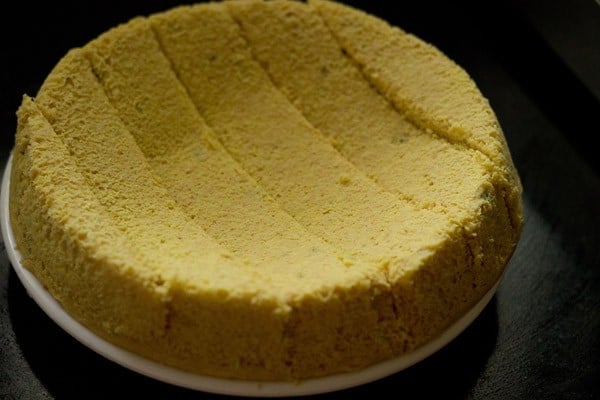
Temper Khaman Dhokla
1. Tempering is essential to infuse the khaman with flavor and add moisture to the gram flour sponge. To make the temper, first heat 2 tablespoons of oil in a small pan on the stove. Use peanut oil or any neutral-tasting oil.
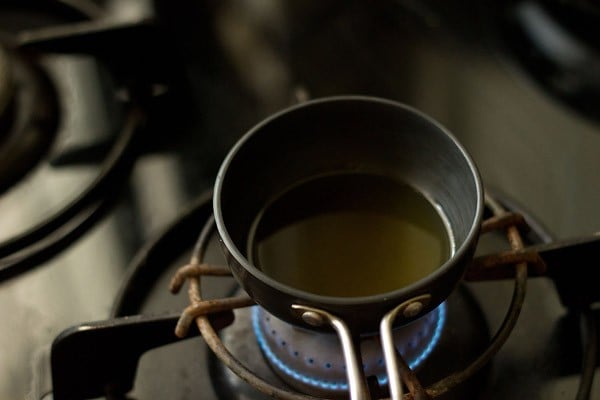
2. Add 1 teaspoon of mustard seeds and allow them to crackle.
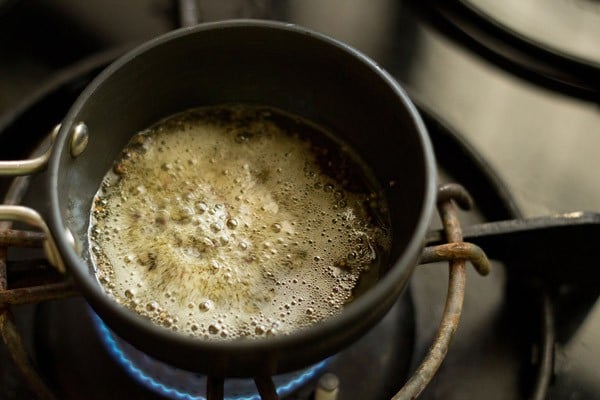
3. When the mustard seeds are crackling, add 10 to 12 curry leaves, and, if you like, 1 teaspoon of cumin seeds and 1 teaspoon of chopped green chili.
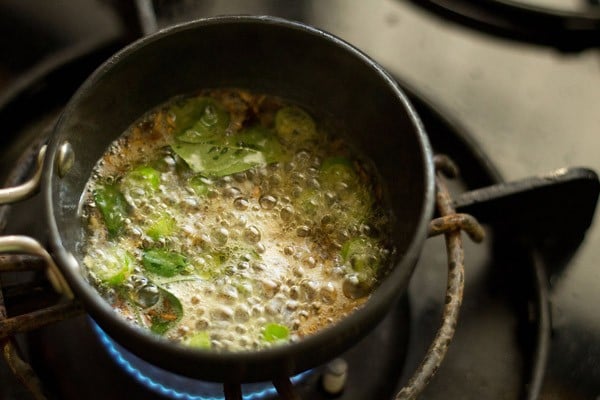
4. Stir and then add 2 teaspoons white sesame seeds.
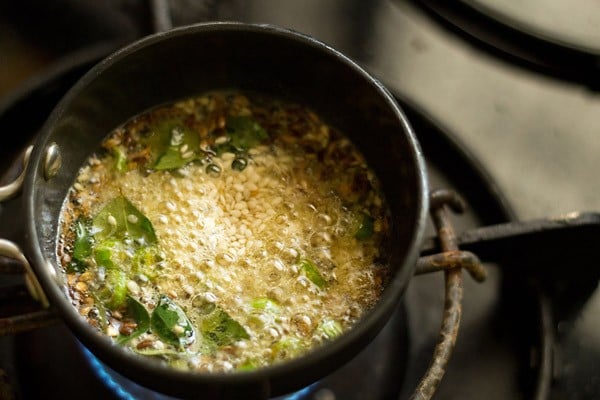
5. Fry the sesame seeds for some seconds. But don’t brown them or they’ll become bitter.
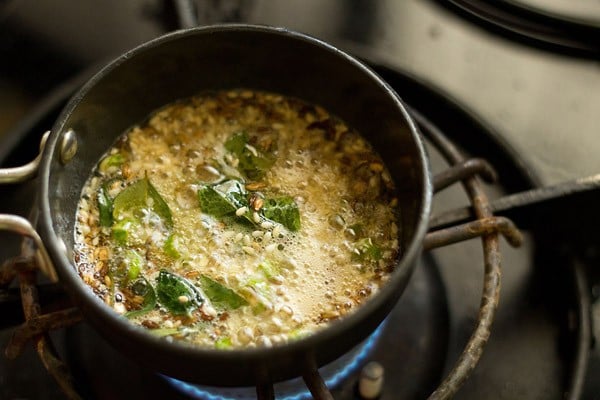
6. Next carefully add ⅓ cup of water. You can switch off the heat when adding water.
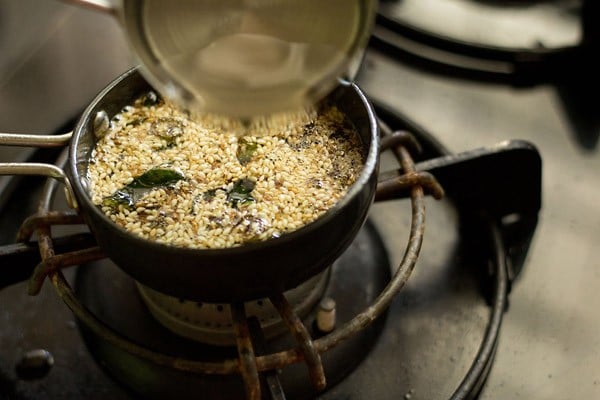
7. Next add 2 teaspoons of sugar.
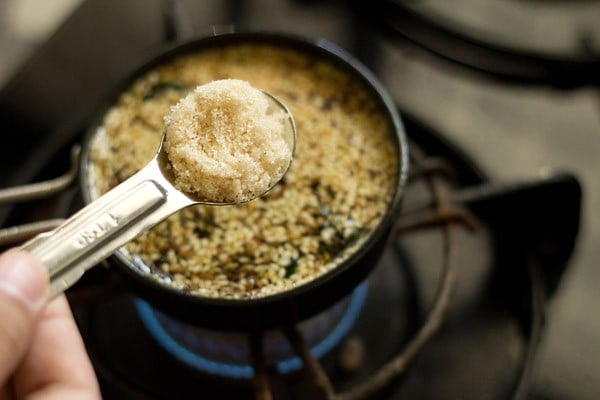
8. Stir and allow the tempering mixture to come to a boil. Make sure that the sugar is dissolved.
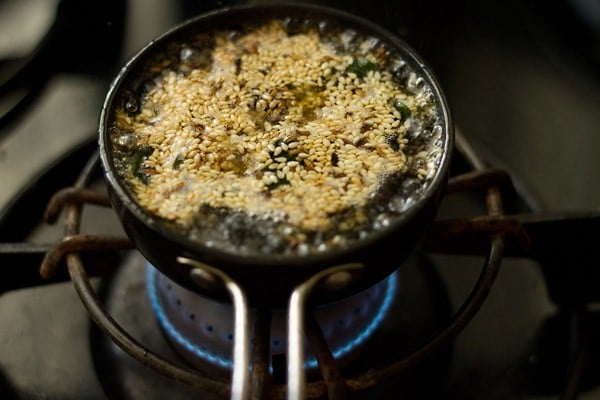
9. Remove from the heat and immediately pour this tempering mixture evenly on the khaman dhokla so that it seeps through the sliced edges.
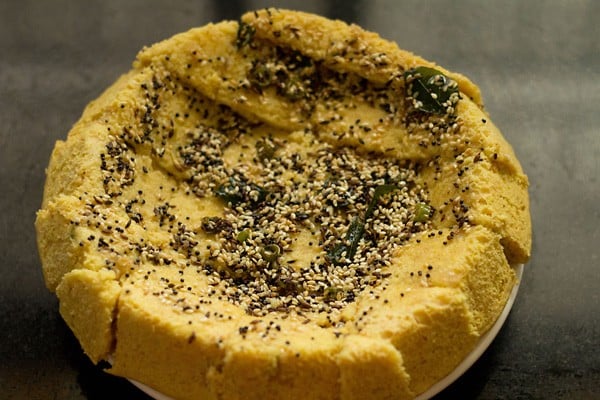
10. Garnish with 2 to 3 tablespoons of chopped coriander leaves and 2 to 3 tablespoons grated coconut, if you like.
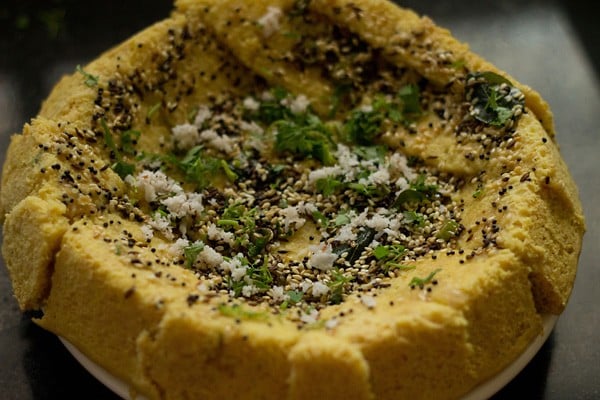
Serving Suggestions
Serve the Khaman Dhokla straight away or you can store it in an airtight box and serve later after an hour. If enjoying khaman later after several hours, then don’t add coconut until ready to eat.
You can also refrigerate them, and then when ready to serve just sprinkle some water and heat in a microwave for a few seconds until just warmed.
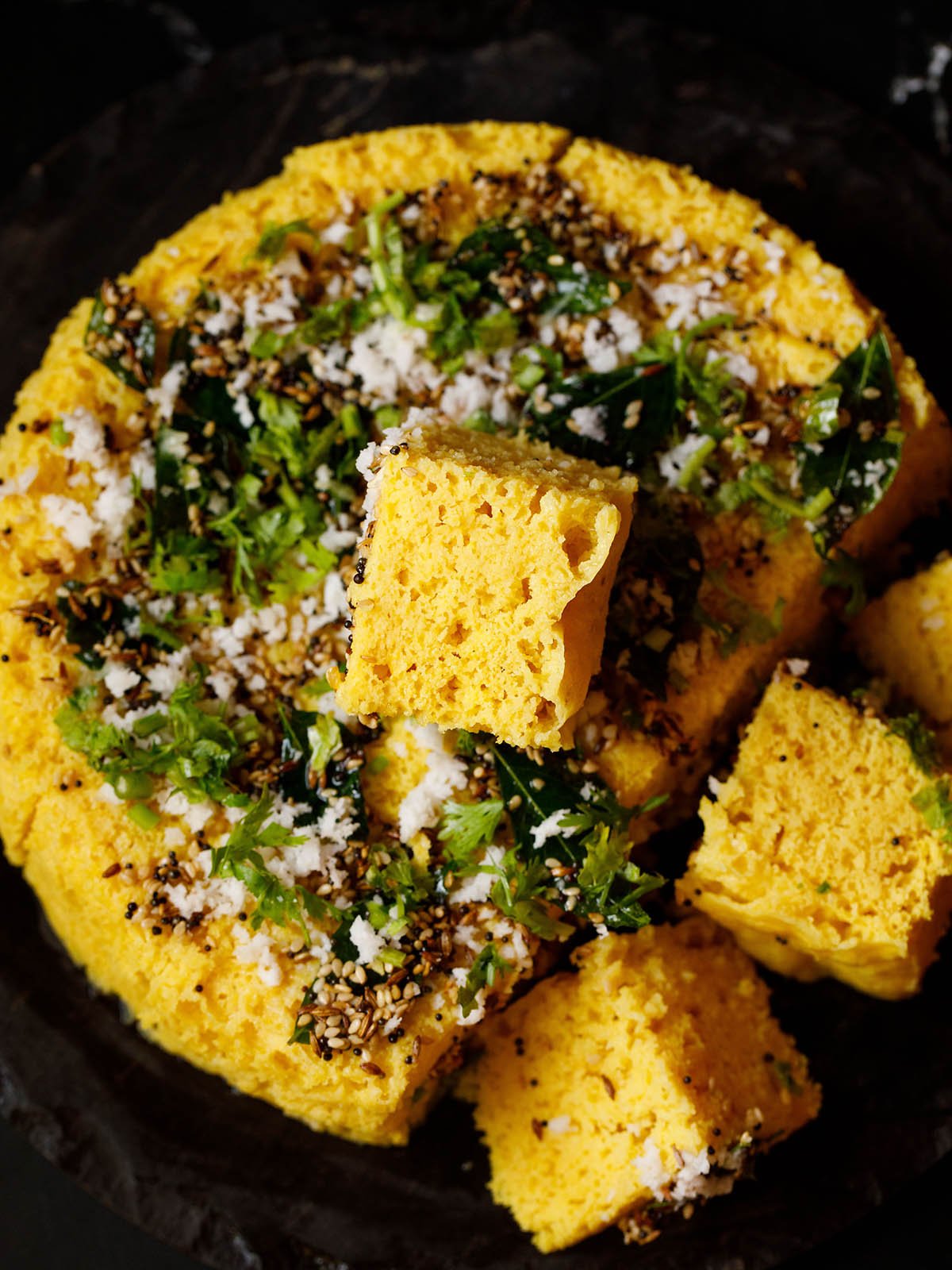
What to eat with Khaman
The sweet, savory, fluffy cakes pair great with our usual assortment of Indian chutneys like Papaya Chutney, Mint Chutney, or even Coriander Chutney.
We also like to pair it with Tamarind Chutney. You can also serve it as a healthy snack with your evening chai.
Storing Suggestions
If you plan to serve khaman after a few hours or next day, then I do not recommend to add coconut or coriander. Simply pour the tempering.
Refrigerate the khaman in a covered container. While serving you can warm with a sprinkling of water in a microwave or an oven.
If using the instant pot to warm, then steam for 1 to 2 minutes. While serving add the coconut and coriander leaves.
Expert Tips
Batter Consistency: The batter consistency has to be flowing but thick to medium-thick. 1 cup water with 1.5 cups of gram flour, always gives me perfect results, but you can add a few tablespoons of water if your batter looks very thick. A super thick batter will make the khaman hard and dense. A thin batter won’t hold shape and will become a mess.
Leavening Ingredient: Feel free to use any of the leavening ingredient. I usually make Khaman Dhokla recipe with eno. Simply ensure that your leavening ingredient is fresh and within its shelf period.
Flavor Adjustments: Khaman always has a sweet and tangy flavor. If you do not prefer the sweetness, I would suggest reducing the sugar but do not omit it entirely. The sweetness balances the tangy taste. You could though add the spices like green chillies and ginger according to your preferences.
Steaming: In a standard pan of 7 to 8 inches, it will take about 12 to 15 minutes for the batter to steam in a pan. Avoid overdoing the steaming as this may result in your Khaman becoming dry and crumbly.
Three Steaming Techniques
You can steam khaman in a pan, stove-top pressure cooker, or in an Instant Pot. I list below in detail on steaming khaman in each.
1: Steaming in a pan or pot
1. Place a small trivet in a large steaming pan that has enough room to keep the pan with the batter. Pour 2 to 2.5 cups of water. Bring it to a boil.
2. Place the batter pan as soon you mix with eno. Cover with a lid (not tight fitting) but one that has a vent or will allow some steam to pass through.
3. Steam for 12 to 15 minutes on medium-high heat. The deeper the pan is in touch with the boiling water, the faster the steaming is. If it is away from the boiling water, the steaming will take a bit more time.
2: Steaming in a stove-top pressure cooker
1. Place the trivet in a pressure cooker. Add 2 to 2.5 cups water. Heat the water until it begins boiling. Secure the pan tightly between tongs and carefully place it on the trivet.
2. Remove the whistle (vent weight) from the lid and seal the lid tightly. Steam for 12 to 15 minutes on medium to medium-high heat.
3: Instant Pot Steaming
1. Pour 2 to 2.5 cups of water in the steel insert of your IP. Place a trivet (not short or long, but kind of in between).
2. Use the sauté function and let the water get heated up and start simmering.
3. Using tongs or with oven mitts carefully place the pan with the khaman batter on the trivet. Do not cover with any lid.
4. Cover and seal IP with its lid and keep the vent position to steam release. Press the steam button and steam on high pressure for 12 to 15 minutes.
5. Keep a check of the time using a clock or watch as Instant pot does will not beep after the elapsed time and will continue to steam. Let all the pressure release and the valve fall down. Then open the lid carefully.
FAQs
The sponginess and light texture in the instant khaman dhokla recipe comes from reaction of eno with lemon juice or citric acid releasing carbon dioxide.
This reaction creates a fizzy bubbly mixture that helps the batter to rise and leaven thereby making it fluffy and spongy when steamed. So if you use less leavening agents (eno, baking soda) or if they are not fresh or active, your khaman won’t be spongy.
Turmeric powder reacts with baking soda or eno to give orange or red colored spots or patches in khaman dhokla. This makes your khaman turn orange or red. This can be avoided by adding less turmeric powder to the batter.
It can be eaten warm or at room temperature.
Adding too much of leavening ingredients like baking soda can make your dhokla bitter.
More Popular Gujarati Snacks!
Gujarati Food Recipes
Snacks Recipes
Gujarati Food Recipes
Gujarati Food Recipes
Please be sure to rate the recipe in the recipe card or leave a comment below if you have made it. For more vegetarian inspirations, Sign Up for my emails or follow me on Instagram, Youtube, Facebook, Pinterest or Twitter.
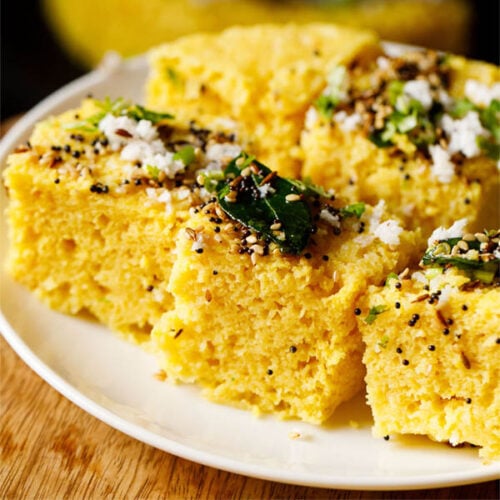
Khaman Dhokla Recipe (Spongy Khaman)
Ingredients
For khaman batter
- 1.5 cups gram flour (besan), 180 grams
- 1 tablespoon rava (semolina) – optional
- 1 tablespoon sugar
- 1.5 inches ginger – crushed to a fine paste in a mortar-pestle
- 1.5 teaspoons green chillies – chopped and then crushed to a fine paste in a mortar-pestle
- 2 to 3 pinches turmeric powder (ground turmeric)
- 1 to 2 pinch asafoetida (hing)
- 1 tablespoon oil – any neutral oil or peanut oil
- 1.5 to 2 teaspoons eno (fruit salt) or ½ to ¾ teaspoon baking soda
- 1 teaspoon salt or add as required
- 1.5 tablespoon lemon juice or ⅓ to ½ teaspoon pure food grade citric acid
- 1 cup water or add as required
For tempering khaman dhokla
- 2 tablespoons oil – any neutral oil or peanut oil
- ⅓ cup water
- 1 teaspoon mustard seeds
- 1 teaspoon cumin seeds – optional
- 2 teaspoons white sesame seeds
- 1 sprig curry leaves – about 10 to 12 curry leaves
- 1 teaspoon green chilies – chopped, optional
- 2 teaspoons sugar or add according to taste
For garnish
- 2 to 3 tablespoons coriander leaves – chopped (cilantro)
- 2 to 3 tablespoons coconut – grated and fresh, optional
Instructions
Making khaman batter
- Grease a steamer pan with 2 to 3 teaspoons of oil.
- Take besan or gram flour in a mixing bowl or pan.
- Add turmeric powder, asafoetida, lemon juice, ginger paste, green chilies paste, sugar, oil and salt.
- Add 1 cup water or as required to make thick yet flowing water. The amount of water required depends on the quality of flour, so add as required.
- Stir and then add the rava or sooji (semolina).
- Stir to a smooth thick batter without any lumps.
- The batter should be thick yet flowing. A quick tip is that if the batter become thin, then add 1 to 2 tablespoons besan.
- Bring to a boil 2 to 2.5 cups of water in a steamer pan or electric cooker or a stove-top pressure cooker.
- The amount of water to be added depends on the size of the steamer or pressure cooker.
- Now add the eno or fruit salt to the batter.
- Stir briskly and quickly. The fruit salt should be mixed evenly with the batter. Or else you get uneven texture in the khaman.
- The batter would froth and become bubbly, so you have to be quick.
- Pour the batter in the greased pan.
Steaming khaman dhokla
- Place the pan in a steamer or electric rice cooker or pressure cooker. The water should already be boiling or hot when you place the pan with the batter. When using pressure cooker, remove the vent weight/whistle from the lid and cover the cooker tightly with its lid.
- Steam for 15 to 20 minutes in an electric cooker. If using a pan or pressure cooker, steam for 12 to 15 minutes on a medium to high heat.
- To check the doneness, insert a toothpick and if it comes out clean, the khaman is done. If the toothpick has the batter on it, then you need to steam for some more time.
- When the khaman become lukewarm or cool, then with a butter knife gently slid along the edges. Keep a plate or tray on top of the pan.
- Invert the pan. If greased well, the khaman will easily get inverted on the plate. Slice and keep aside.
Tempering
- In a small pan, heat oil.
- Add mustard seeds and let them to crackle.
- When the mustard seeds are crackling, add the cumin seeds (optional), curry leaves and chopped green chilies (optional).
- Stir and then add sesame seeds.
- Fry the sesame seeds for some seconds but do not brown them.
- Then add water. Be careful while adding water as the mixture sizzles. You can switch off the heat when adding water.
- Add sugar. Stir and allow the tempering mixture to come to a boil. Make sure that the sugar has dissolved in the water.
- Then pour this tempering mixture evenly on the steamed and sliced khaman.
- Garnish with chopped coriander seeds and grated coconut.
- Serve khaman dhokla straight away or you can store them in an air tight box and then serve later after some minutes or an hour.
- If serving khaman after many hours, then do not garnish with coconut and coriander leaves.
Serving Suggestions
- The sweet, savory, fluffy cakes pair great with any spicy or sweet Indian chutney.
- You can also serve it with your evening chai.
Storing Suggestions
- If you plan to serve khaman after a few hours or next day, then I do not recommend to add coconut or coriander leaves. Simply pour the tempering.
- Refrigerate the khaman in a covered container. While serving you can warm with a sprinkling of water in a microwave or an oven.
- If using the instant pot to warm, then steam for 1 to 2 minutes. While serving add the coconut and coriander leaves.
Video
Notes
Ingredient Notes
- Eno: Use the regular plain eno without any flavors.
- Gluten-free: For making khaman gluten free, skip the asafoetida and semolina.
- Baking soda or Eno: The ingredient which we use to leaven the khaman batter is fruit salt. Eno is a popular Indian brand of fruit salt. You can also use baking soda. However baking soda gives the soapy aroma if used in excess. Again both eno and baking soda react with turmeric powder and gives a red tinge or red spots in khaman. So add little turmeric powder or skip it completely.
Recipe Notes
1. Batter consistency The consistency of the batter is flowing but thick to medium-thick. 1 cup water with 1.5 cups of gram flour, always gives me perfect results, but you can add a few tablespoons of water if your batter looks very thick. A super thick batter will make the khaman hard and dense. A thin batter won’t hold shape and will become a mess. 2. Steaming Methods You can steam khaman in a pan, stove-top pressure cooker, or in an Instant Pot. I list below in detail on steaming khaman in each. a) Steaming in a pan or pot- Place a small trivet in a large steaming pan that has enough room to keep the pan with the batter. Pour 2 to 2.5 cups of water. Bring it to a boil.
- Place the batter pan as soon you mix with eno. Cover with a lid (not tight fitting) but one that has a vent or will allow some steam to pass through.
- Steam for 12 to 15 minutes on medium-high heat. The deeper the pan is in touch with the boiling water, the faster the steaming is. If it is away from the boiling water, the steaming will take a bit more time.
- Place the trivet in a pressure cooker. Add 2 to 2.5 cups water. Heat the water until it begins boiling. Secure the pan tightly between tongs and carefully place it on the trivet.
- Remove the whistle (vent weight) from the lid and seal the lid tightly. Steam for 12 to 15 minutes on medium to medium-high heat.
- Pour 2 to 2.5 cups of water in the steel insert of your IP. Place a trivet (not short or long, but kind of in between).
- Use the sauté function and let the water get heated up and start simmering.
- Using tongs or with oven mitts carefully place the prepared pan with the khaman batter on the trivet. Do not cover with any lid.
- Cover and seal IP with its lid and keep the vent position to steam release. Press the steam button and steam on high pressure for 12 to 15 minutes.
- Keep a check of the time using a clock or watch as Instant pot does will not beep after the elapsed time and will continue to steam. Let all the pressure release and the valve fall down. Then open the lid carefully.
Nutrition Info (Approximate Values)
This Khaman Dhokla recipe from the archives was first published on August 2012. It has been updated and republished on June 2024.
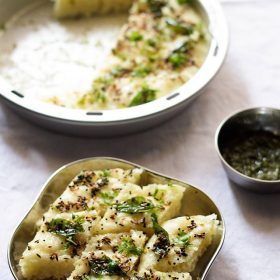
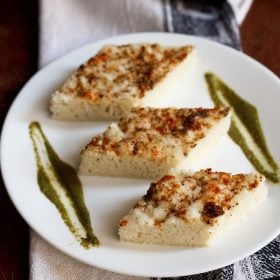
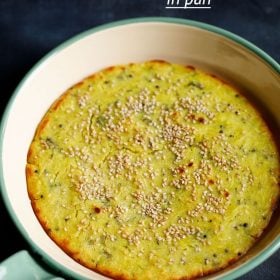
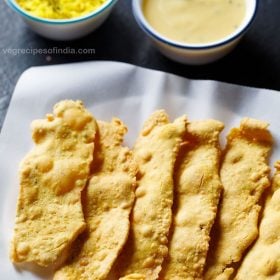
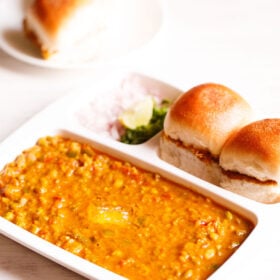
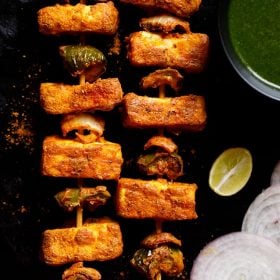
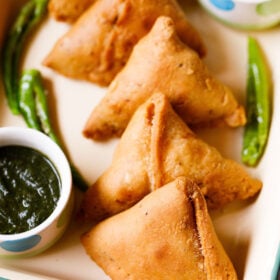
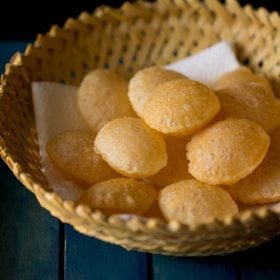








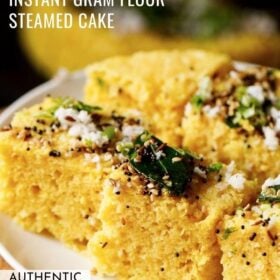
Thank you for this recipe! Tried it out today. It’s super delicious!
Thanks for sharing the feedback. Nice to know.
it came out great thanks to your clear instructions!! perfectly soft & delicious
Lovely and thank you. Nice to know.
I tried it today… It was awesome.. My daughter loved it. Thanks a ton…
Great and thanks for letting me know.
I totally love this dhokla recipe!!!! Can you steam this and freeze it before putting the tempering on it. If so, would I thaw and reheat in steamer or microwave?
Thanks. Yes you can freeze dhokla. Thaw and reheat it until warm in a steamer or using the steam function in an Instant Pot. If reheating in a microwave, sprinkle some water on the dhokla and reheat it.
I am searching for your traditional dhokla recipe with soaked dal and rice but unable to find . Would you please share the recipe.
Hope you will reply soon.
I will post it in some days.
I don’t understand why people say that only video recipe can help you cook perfect.
Yesterday, i came across your blog and i tried this khaman recipe and it really turned out awesome. Thank you for this perfect recipe.
Thanks a lot Bhavana. It depends – some people prefer videos and some prefer step-wise photos. I personally feel that videos do not help much while cooking, but it just me that thinks this way. I am glad the recipe turned great and thanks for sharing this. Welcome and happy cooking.
Tried this recipe today and dhokla came out just awesome. I have never made dhokla without curd earlier…so, I was bit doubtful while started with this recipe. But this came out just superb. Thanks for sharing.
Thank you Neha for the positive review on the recipe and the rating as well. I am glad that the recipe was a success. Welcome.
I tried the same recipe.. the base turned out to be very fluffy and spongy but.. when i poured the tempered water over it.. it was still dry from inside not as watery as market dhokla.. then again when i tried the recipe with more water it bacame soggy what should i do??? I need help with the tempering part only.. want to make as liquidy and spongy as market dhokla.
Looks like either the water was less in the batter or the dhokla has been overcooked. Both will result in dryness. If you add little more extra water it won’t be soggy. But if more water is added from top, it will become soggy. The moistness in the dhokla is not due to the addition of water while tempering but is in the consistency of the batter. Try reducing the steaming part by some minutes or adding slightly more water. Sometimes depending on the quality and texture of besan, more water will be needed.
Thank you so much for this recipe. I tried today in fact just now and it turned out well .
You are an angel dassana.. since 2 years I forgot this website n started following those good for nothing YouTube channels and every recipe was a disaster. Now I m back to you dear.. now everything will be awesome. I tried this dhokla and was soft n spongy.. thanks my angel
thank you monika for this sweet comment. good to see you back. do try some more recipes and i am sure they will be good.
My dhoklas were not soft as we get from outside what could be the reason????
mamta, could be that the baking soda or eno used was not fresh and active. if the eno is not active it won’t react and the dhokla will have no sponginess. when using eno or baking soda, its always better to use them within their expiry date.
Hey,
Tried this receipt today and everyone loved it , the only problem was that it was less sour. Otherwise it is awsm
Thanks Nupur. However khaman dhokla does not have a sour taste. If you want little sour taste then while making the dhokla batter check the taste and at that time you can add little more lemon juice.
can I use pressure cooker to steam? if yes how?
please explain diff between cooking soda, baking soda ,soda bi carb,and baking powder.
these 4 powders confuse me.
thanks.
arusha, you can use pressure cook to steam. just add 2 to 2.5 cups water in a 5 litre pressure cooker. place the channi like plate which we get with pressure cooker in the water. then place the dhokla pan. remove the whistle from the lid. cover the pressure cooker with the lid and steam for 10 to 12 minutes or more time till the dhokla is steamed well.
normal cooking soda and baking soda are same. baking soda is pure sodium bicarbonate or soda bi carb – when moistened releases carbon dioxide which helps in rising of baked stuff. baking powder contains sodium bicarbonate, an acidifying agent (cream of tartar), and also a drying agent (usually starch). same function as baking soda. however baking soda is more strong.
thank u
dassana…will try again.
about 1 year ago u had corrected my mistake in making pavbhaji and since then my pavbhaji has been as good as Bombay pavbhaji. All residents of my building like my pavbhaji….thanks for your small tip that helped big way.
welcome and thanks arusha. do try again. also use fresh eno as if the eno is not fresh or active the dhokla will become dense. felt good reading about the pav bhaji recipe. happy cooking.
Awesome receipe… Im a star every time I make it … All thanks to you… Thank you so much for sharing… God bless you ????
Welcome Nisha. Glad to know that everyone likes this dhokla recipe prepared by you. Thanks for your best wishes.
Hi Dassanaji,
I keep on trying your different recipes and all of them turn really good.. for this recipe I have a query regarding the water to be put in the pan for steaming- the batter vessel should be at what level above the water ???
Thanking you.
thanks divya. the water should just touch about 1/2 to 1 inch of the batter vessel.
Hi Dassana,
I tried the dhokla today, everything looked fine until i cut it into pieces. It was not spongy and i could get the taste of besan. Could you help me understand what might have gone wrong? ☹️
P.S. love your app and recipes!
mohita, if the dhokla is not spongy, the the baking soda or eno used in the recipe is not fresh or past its expiry date. other that there is no reason why the dhokla should not be spongy. taste of besan is as the dhokla has not cooked. when you use eno or baking soda, always check it in a bit of water or a mixture of water and vinegar. if it fizzes and bubbles, the eno or baking soda is fresh & active and can be used.
nice recipe…dhokla came out v nice!! thanks dassana:)
welcome purvaja. glad to know this.
Hi Dassana,
I made this dhokla today for lunch and it was liked by everyone (our first home-made dhokla). It turned out very spongy, flavorful & soft. Ginger-chilly paste, fresh curry leaves & sesame seeds were great taste enhancers.
Keep sharing such tasty recipes. Thank you.
thanks a lot ruchi for this lovely comment. i am glad that for the first time you managed it well. thanks again and happy cooking.
Thankyou so much Dassana!!!
Welcome Shilpa
Hi Dassana
Is there any difference between the texture and taste of dhokla prepared with adding curd or without it?
texture is same, but the taste is different. dhokla made with curd has the sourness of curd in it.
Hi I prepared dhokla but it can’t rise properly & no spongy also.why ?
eno or baking soda should be active and fresh as that the only leavening ingredient used in the recipe. could be that the eno or baking soda was not fresh or expired. thus the dhokla has not risen as well as is not spongy. when you add you should see fizz and bubbles in the batter.
I am drawn to your blog as you are one of very few food bloggers who list the amount of salt you add to a recipe.
Some of us are new to cooking, and cannot determine how much salt to use, when the recipe calls for “salt” or “salt to taste”.
Thank you so much for listing the amount of salt.
thanks lana for these words. but i only mention salt in some recipes. in most recipes like a dal or gravy, i do not mention salt. reason being everybody’s salt preferences are different. but still i try to add the salt measurements in some recipes.
Hello Dassana,
First, thanks for your kind assistance with my queries. It’s deeply appreciated. 🙂
I was wanting to ask you how to go about making dhokla in an electric pressure cooker. Since I am not sure whether the weight on a pressure cooker can be removed safely, could you tell me if it’s possible to keep the weight on? If so, how long would one cook the dhokla?
thanks kate. i have never used an electric pressure cooker. but keeping in mind the pressure cooking principles, i think you will need to remove the vent weight. if pressure is created in the cooker, then due to too much of steam, the dhokla will get a batter like consistency. even i am not very sure about the electric cooker and if its safe to remove the vent weight. so i would suggest to steam the dhokla in a pan or pot. heat water in a pan. place the dhokla pan or bowl in the pan containing water. but do make sure that the water does not spill over inside the dhokla pan while boiling. cover the pan with a lid which has a vent or keep the lid a little loose on the pan, so that some steam can pass away.
Hi dassana,
What is the make/model of the dhokla steamer that you have used in this recipe?
ruchi, this steamer came with the panasonic electric cooker i had purchased. its made from aluminium.
What if not having aluminum pan ? Can I use steel plate for batter in the steaming process in pressure cooker
yes you can use steel plate or any steel pan.
hello good mrng can I make dhokla in OTG ..if yes plzz tell me the process
good day pratibha. i have never made dhokla in OTG, so i do not know how texture will be of dhokla and also i do not know the process or method.
Thanks ..really so easy and quick recipe of dhokla
welcome sandhya.
Hi dassana, does the size of the pan matter while making this dhokla?
May i know the size of your pan that you have used in your electric cooker.
Thanks.
hina, yes it does matter. the pan size is 9×1.5 inches.
Thanks for this info Dassana, I made it in a smaller pan so the dhokla became high instead of wide, if you know what I mean. Taste was good but the tempering doesnt reach the bottom and its a bit dry…
Welcome Sneha. The pan should be of medium size around 7-8 inches in diameter.
Hi Dassana, I did try the khaman dhokla recipe for breakfast today. It came out superbly well! All liked it and it was super easy in the microwave for 2mins and 30 secs in a plastic microwave dish. I used curd whey instead of water in the seasoning to moisten because that’s what I used to do with the ready mix I used to earlier buy. That’s the only change and we had it with mint, tamarind and coriander sweet chutney. It was just awesome! Thanks a ton!!
welcome sonia, glad you liked the khaman dhokla 🙂 thanks for positive views.
great sonia and thanks for letting me know. both curd whey as well as curd or even buttermilk can be used in the batter instead of water. i am sure the whey must have tasted very good in the seasoning.
Yummmm! My mouth is watering already just looking at the pics as usual. Will try making it in the microwave cos tomorrow as it seems much quicker. I’m sure its going to be awesome-all your recipes are always spot on and oh! sooooooooooo delicious! You know I fully credit your site alone Dassana, for making me and my family more “vegetarian” (and willingly so!) than ever before I discovered this brilliant site about 4-5 years ago!
thanks a lot sonia. nice to know and i hope dhoklas come out good. microwave method is easier, but microwave in parts and check. happy cooking 🙂
Very desirable recipes. Tried few and the result was just great. The recipes surely deserve appreciation and thank notes!
welcome shilpika. thanks for your positive feedback.
Hi dassana.. I have tried many recipes from your site and they turned out to be really tasty.. only thing I had a problem with thia dhokla recipe is that mine didn’t come out fluffy.. it didn’t rise at all.. it was just like a besan base and little sticky.. what could be the reason? I felt very disappointed. .
you use eno or baking soda. the eno or baking soda, must be past its shelf life and not active. thats why the dhoklas did not turn out fluffy and sticky.
Awessssom recipe… Worked out very nicely…
Thnq once again 🙂
welcome always pooja, thanks for positive views 🙂
Thank you for sharing the recipe…
We are planning to try it out but there’s one thing I need to get clarified…
For steaming the dhokla, can I use any usual stainless steel container? Or does it have to be an aluminium one? I wouldn’t mind much the shape…
And while steaming, can the pan be rested in the boiling water? I don’t have any hanging-above arrangement in my pressure cooker.
Thank you
welcome ruchi. you can use any steel container. but just grease it well, so that the dhokla comes out easily without getting stuck. yes, the pan can be rested in boiling water. do make sure that when the water is boiling, it does not fall on the dhokla batter inside the pan. the water should just touch 1 to 1.5 inch of the pan from the bottom.
Thank you for the help on procedure!
I tried the recipe today but the dhokla was uncooked except the top layer (then i went on to steam further for over an hour hoping that it’d get done but with no success)… I’ve tried many recipes from your blog and they all turn out great so I am suspecting my steaming method… if you could just verify if it’s alright..
In the cooker, after pouring water, I placed an inverted perforated plate over which I placed the utensil/mould containing dhokla batter. I covered the mould with another small plate to prevent steam from getting in touch with batter directly (since the mould was lying at a much lower level than cooker height).
Then I closed the cooker with its lid sans whistle and went ahead with steaming.
Was the steaming method alright? [sorry if it all sounds stupid, actually we have never tried any steamed dish at home like idli, dhokla etc]
welcome ruchi. looks like some water has gone in the batter while cooking. so the base is batter like and the top has got cooked. you can keep the flat jali round base that we get with pressure cooker at the bottom and then place the dhokla batter pan on top of it. cover with a lid while steaming. some steam outlet should be there, while steaming, so do not cover tightly, the way we cover when cooking rice or lentils.
using the perforated plate is fine. thats what i mentioned above. but do not cover the dhokla batter pan with a lid. keep it open. also secure the cooker lid tightly, but do not use whistle. looks like since you kept a lid on the pan, steam has formed in the pan and the batter looks uncooked. so my above reasonings are not right. also cooked height does not matter. if you want you can keep a heat proof stand inside the cooker and place the bowl on the stand.
Hi Amit
Thank you for your easy yet amazing recipes, I was in hostel after school for 10years for studies and at home also was never interested in going to kitchen, had always been a spoilt baby,, now after marriage I started learning recipes slowly and gradually and enjoying doing that rather, me n my husband both are big foodies thank you so much you saved me with your recipes with photos, ps. My inlaws visited us and your Punjabi kadhi, dhokla, chilly mushroom etc recipes were loved by each n everyone at home and got me so much appreciation
Welcome Swati. Glad to know that recipes are helping you in learning cooking. Feel free to ask any query about recipes posted. I will be glad to help you.
I once made the microwave version and was a hit.. Can we make this without eno.. And is there any possibility of making the recipe by grinding chana dal and fermenting it like idli batter?
thanks ashrita. there is a method of grinding chana dal and fermenting like idli batter. soak 1 cup chana dal first for a few hours. then grind with some ginger and green chilies to a paste. the batter should have a rava like consistency in the ground chana dal. add water as required while grinding to make a thick batter like idli batter. then add 1 to 2 tablespoons of curd or 1/2 tablespoon lemon juice in the batter along with salt and mix well. cover and ferment overnight or 6 to 7 hours. then make dhoklas. but here you do need to add some baking soda. so for 1 cup of chana dal, you can add 1/4 to 1/3 teaspoon baking soda. hope this helps. you can also add cumin seeds and a pinch of hing while grinding chana dal.
Thank you so much for such a detailed reply dassana.. U really rock in this.. I would try it for soon and would let you know.. Btw I’m a regular reader and I swear by your recipes.. Have made Palak paneer, cookies, cauliflower curry, methi ke paranthe and a lot more to list.. And till date no recipes from your space has turned me down.. Keep rocking..
thanks ashrita for trying so many dishes and for positive views.
Hello mam. .u r wonderful in teaching people about cooking. I made this recipe yesterday night It came out out soft and delicious. Credit goes to you.
I have one question my hubby said he ate dhokla somewhere where they took dhokla out of water to serve.i didn’t get this.do u know anything about water he is talking about.will be very helpful
thanks seerat for the feedback. i am not aware about taking dhoklas out of water. i have never seen such a thing 🙂
hello Dassana!
i just cooked this awesome dhokla and it came out sooooo delisiously we couldt stop eat till last crumble. I used 1/2 tsp soda coz in russia we dont have fruit salt but there was no hint of alcaline in dhokla…. i was a little bit worry about 1/3 cup of water for tempering coz i bothered that dhokla would become loose and watery but i trusted you blindly as usual and it came out perfect!! it was melting in mouth soft and spongy.
you have a great gift – to cook and to teach. (and to take fabulous food photo!))))please keep teaching and inspiring us!
thank you sooo much!!!
very pleased to know this ksenia 🙂 glad your folks liked the khaman dhokla. thank you for your kind and encouraging words. you are always welcome.
Hii i always follow ur recipes and they come very tasty.my doubt is if we steam it like idli can we cover it with lid
yes you have to cover with a lid. but there should be an outlet for the steam to pass in the lid.
hello mam,I want to ask you that when i make dhokla in microwave it does not prepare well.It makes spongy but somewhere dry and wet on a same loaf of dhokla although i put too much water on it. Kindly help me out
could be that the microwave oven is not cooking the dhokla evenly. should not actually happen. what you can do is microwave at a low to medium power. so that the dhokla remains soft and does not get dry and also cooks evenly.
Hello love your recipes.. While making dhokla my dhokla just gets cooked at upper level.. At bottom dhokla remains uncooked. Y does this happens?? Please tell me.
thanks priyanka. actually it should not happen. the water which is used for steaming should not go into the batter or some other issue. not easy to guess.
Thanks for providing simple steps, dhokla came out very soft
thanks for sharing this saras 🙂
I made it after very long time, forgotten my recipe, not remembered
ok thankyou 🙂
Thankz for this recipe. Came out very well-soft, fluffy and yummy 🙂
thanks for the positive feedback bindu.
thanks for the receipe….I tried but didnt get tht fluffy…wht can be the reason for the same
could be that the eno or baking soda must not be active/fresh or past their shelf life. for any recipe that use eno or baking soda, always use them fresh and within their expiry date.
Hai..i alwys visit ds site…its a superb site helps us to improve our cooking skills..dhokla one f ma fav dish…i am frm Kerala..dhokla s nt available here .i had t from Mumbai..i wish to make t…i hav one doubt…shoul i use baking soda instead f eno??? Or eno s compulsory fr dhokla..??plz reply…thank u sithara
you can use baking soda. but at times with baking soda, you can get orangish reddish color in the dhokla. this is due to the reaction between turmeric and baking soda.
Hi,
I want to try this recipe in rice cooker but the steam pan is not as you have shown i pictures..it has holes in it so what do I use in that case?
please reply soon n thank u
the steam pan with holes is used for steaming veggies. i would not suggest using this steam pan for steaming dhokla. you can use any other bowl or pan which can fit inside this steaming pan which you have.
Thnks for ur delicious recipies .. Dhokla was very yummiee bt its lower part was bit hard.cn u suggest me the way to avoid dat issue?
simar, when you add the eno, you have to mix it really well. if not mixed very well, then some parts of the batter won’t be fluffy when cooked. also could be that the dhokla was steamed too much, hence the lower part became dense. next time, mix the eno very well with the batter. then after pouring the batter in a pan, gently shake the pan, so that the batter spreads and evens out in the pan. then steam the dhokla.
I really like your recipes and mostly d way u presented it..whenever i want to prepare any wish i definitely follow your way..
Thank u so much for such luvly guidance.
thank you much suman.
Thank you so much mam, with ur wonderful guidance I m nw able to prepare fine dhoklas,
glad to know this and thankyou maya also you are always welcome.
Hi can I skip sugar while tempering. Basically my husband doesn’t like sweetish tinge.thanks
yes you can skip sugar.
Dear madam
Thanks a lot for the recipe can I make the dhoklas in idle steamer
yes you can make. just steam dhokla, the way you steam idlis.
tried.. .its excellent!
second time I added a little (2 spns)of curd and a spn of veg oil.believe that gave a nice tangy taste and soft texture.do u think its fine?
another question ‘ should I keep the dhokla pan/mould uncovered while steamimg in the pressure cooker?
pl answer
thanks. its fine to add the extra teaspoons of curd and some oil. addition of oil gives a moistness to the dhokla. no need to keep the pan covered with anything while steaming in the cooker.
Hi dasana,
. can I use citric acid, instead of lemon juice?if yes in what proprtion..
Also I want to serve it in evening party , but make in morning, and I m confused as to how will it work, for tempering and also its softness
Thanks
Sonu
you can use citric acid. but i am not sure about the proportions. so can try with a small batch. make in the morning. then temper. before serving, just sprinkle some water and microwave for a few seconds. garnish with coconut and then serve. don’t add coconut after you temper. keep the dhokla covered in a bowl or container with a lid.
Ok… You mean not add water in temper, and garinish after with coconut??? Plz specify… Do I need to cut in pieces before tempering??
Sonu
yes do add water while tempering. then don’t garnish with coconut. you can though garnish with coriander leaves if you want. do keep the dhokla in a container. then before serving, just sprinkle a bit of water on them and microwave just to make them warm. then you garnish with coconut. yes you need to cut in pieces before tempering.
As usual another superlative experience from one of your recipe guides. My wife asked “how did you do this”. To my unbelievable credit I did not plagiarize. I said “it’s all on the Internet”. Dassana you are to be highly commended. Are you based in New Delhi? Send me your full postal details please. I do not believe in taking without giving. Best regards. Rohit.
thank you very much rohit for the kind words and for your thoughtful gesture. your gesture already has already made me feel good. so nothing more is required 🙂
fyi – i am not based in delhi. thanks once again.
Hi Dassana, its me again with a query….i made this dhokla again today… it did froth and also there were bubbles .. but while eating it felt very dry .. i followed exatly what you hv done… where am i going wrong .. did i put too much besan or less water while mixing or i dont know…. or i should steam it for a longer time .. pls help .. i dont want to fail the third time ….
thanks dassana for all your replies …
tk care and regards
marina
Okay. Dryness could be due to less water or too much steaming. So try adding a few tbsp more water or steam of lesd time. Welcome marina.
hi dassana, i had made this dhokala for the first time.. it did taste but it was not very soft … ofcourse it was not hard also … what could hv gone wrong.. i used eno lemon flavour.. when i added eno it did not froth and there were no bubbles .. u think that could be the reason or something else or at the end i used less water in the tadka ….
thanks for your reply in advance ..
rgds n tk care
marina
hi marina, the batter should froth and bubble as soon as you add eno. if it does not, then it means that the eno was not fresh, meaning it had expired and not active. this is also true for ingredients like baking soda and baking powder. so this could be the reason for the dhokla not being soft. for the tadka, its fine if you use less water. even if water is not added in the tadka, its fine.
I made dhokla today using microwave and it came out really well n tasted really gud. Except i felt the edge to b a bit hard , it ws nt dat mch noticable bt if eaten vry fast v cn feel it. Wat do you think can b d prob? Also my mum made dhokla wid curd. Wat if v substitute water wid curd? Thanx fr a great recipie …i always follow your recipes.
if the dhokla gets cooked too much in the microwave, it will harden. even if its cooked for some more seconds, it will get overcooked. with microwave, the food even gets cooked after its removed from the microwave oven. so while making any dish in the microwave, cook for some seconds or minutes check the doneness and if not cooked, then again place the pan in the microwave. you can add curd instead of water. but i would suggest adding both water and curd. skip lemon juice, if you add curd.
I like this website
Hey!
I tried your dhokla recipe today. And midway realised i had just a teaspoon of eno instead of the two as needed in the recipe. So, i substituted equalequal measures of baking siad and powder to make up the lacking teaspoon.
Well guess what, the dhokla was well shaped and risen. I’m so glad. It was my first try at dhokla making.
Other than the rising agent, i wholly followed your recipe.
Haven’t tasted it yet, as we all are fasting for ramadan. It seems it will be delicious!
thanks wardah and good to know that the dhokla came out well 🙂
hi what can i use instead of lime juice???
you can use curd/yogurt.
Ur recipes always do woonders in my life. I was most happy person to make a perfect dhokla for my family. Thanks a ton.
welcome barnali. glad to know this.
Ur recipes always do wonders in my life. I was most happy person to make a perfect dhokla for my family. Thanks a ton.
welcome barnali. glad to know this.
hai, can i use Eno lime flavour.
divi, yes you can use. a reader had tried and it turned out well.
Hello Dassana,
I simply loved the way you have explained even the minutest of details here. The recipe presented in a step by step format is a pure joy to watch too and none the less needs to be tried as well.
I love cooking dhoklas. I have tried to get a dhokla steamer but have not yet succeeded.
So, i end up making or steaming them in my pressure cooker prestige.
I have one basic question to ask. As you have already mentioned that we need not use the whistle of the cooker while steaming it, then should i be using the gasket or the rubber on the inside of the lid.
What i have been doing so far is i do not use the gasket , simply close the lid , keep the whistle or the weight and steam the dhokla batter. and normally it turns out fine but a lot of times it takes over 20 mins to cook..
So help me out with my query please.
Have a good day ahead.
Kirti
thanks a lot kirti. yes you do need to use the gasket. before getting an electric cooker, i would use the pressure cooker for steaming dhokla. i would use the gasket then. 20 minutes is a long time. with the gasket it would not take so long.
Nice of you to post this with options for gluten free – it’s also dairy-free, which is helpful as many versions contain yogurt or buttermilk.
thanks mvp for your kind words. wherever possible, i always try to give options or variations.
it s really easy nd simple way to cook. really nice and good.
thanks gagandeep
I tried this out and the results were fantastic.. Its really simple adn quick to make… Needless to say I was complimented by all who ate the dhokla. Thank you
welcome alland. glad to know this. thanks for sharing your experience.
Hi dassana,
I have tried many recipes from ur blog and really want to thank you for making cooking super easy for newly married women like me .. Every time I tried out a recipe it turned out to be perfect. Thanks to detailed pictures n instructions. Thanks again.. 🙂
welcome daisy. glad to know that the blog is helping you in cooking.
Wonderful! I just wanted to know is it ok to prepare this mixture in the night and keep it for fermenting and then readily bake it in the morning..Does this mean that the eno can be skipped if kept for fermenting..Being a working woman just asking.
hi pooja, from what i know, the dhokla which is fermented is soaked ground chana dal and yogurt/buttermilk. i don’t think this batter will taste good if fermented. as the besan gets a sour taste which is not pleasant to the palate.
Thanks for the wonderful recipe … Dhokla came out really well.
welcome somya. glad to know this.
nice receipe but list of material require not available
ingredient list and method right towards the end after the step by step pics.
must testy food as indian cake ..We can use green chilly too
thanks pallavi
Hi dassana, thanks for the wonderful recipie. Microwave cooking is fast n easy but doesn’t work when we wnt to cook in advance. Can we bake dhokla instead of steaming in a baking oven ?
welcome. you can steam these dhoklas in a pan or pressure cooker or an electric rice cooker, instead of baking.
Hi Dassana,
My cooking skills arent really up to the mark..but lately have been following many of your recipes and getting all the praise from my family 😉
Love all your recipes, the step by step instructions, tips and all your pictures are really mind blowing! I love how you describe everything in detail. This site has become like a bible for me. Even if I want to try any recipe from any other source, I first come here and check about it. Only if I find it here, do I try it…gives me the confidence to try new things. ..have been planning to write this since a long time…thanks a lot…
now about the dhokla I tried making today, it wasn’t that fluffy as I expected. Correct me if I an wrong but its because I used baking soda instead of eno. Will try it again after a few days.
Looking forward to learn more from you and your site.
thanks once again,
Uma.
thanks uma for all the positive feedback and praise. humbled.
eno works best in dhokla. again if the baking soda is active meaning still in its shelf period, then the dhokla will become soft. if the baking soda is not active, then the dhokla will turn out dense. i generally don’t add baking soda as i do not like its alkaline odor. hence i prefer adding eno. try increasing the baking soda to 1 tsp. it should give you a better result. i will be updating this post with the steamed version soon and with better pics.
I followed your microwave recipe as closely as possible, but the dhokla turned out orange. It took longer to cook and didn’t taste like I expected either. Why do you think that happened? Please guide. I’m a novice cook, but your recipes generally turn out fabulous, so I trust them completely.
orange or reddish tones is due to the reaction of alkali and acid. in this case its due to alkali – baking soda or eno and acidic – lemon juice. the recipe gives soft dhokla. you have mentioned whether the texture did not come out as expected or the taste was different. also in a microwave timings do differ from oven to oven.
hi,
can I add curd and red chilli powder in the batter and can I leave the batter for 4hours or more to mix well.
can I add long green chillies for the tempering
thnks
yes neha, you can add curd and red chilli powder in the batter. skip lemon juice in this case, as you are already adding curd. you can keep for some hours. but don’t add eno or baking soda and keep for 4 hours. just add either of them, when you are about to microwave or steam the dhokla.
I used lemon flavoured eno. Dhokla turned out amazing! Loved it.
thanks wari for letting me know. good the lemon flavored eno worked.
Hey Dassana. Even I could never make a good dhokla. It always turned out to be soggy. I was starting to doubt my cooking skills! But thanks to your microwave recipe I made it in a few mins. I made this just now and it turned out to be awesome. Can’t thank you enough.
thats nice to know richa. welcome 🙂
What is fruit salt? Which eno flavour would u recommend?
fruit salt is eno. i recommend plain eno without any flavors.
Thanks for this recipe dassana ji…I made it yesterday…it really came out so good….I wanted to make khandvi…but I didnt find it in ur blog..can u plz put up ths recipe bcz I used to follow ur recipes. .
welcome anjali. i have got few request for khandvi but not able to post it. i will post it soon.
Thanks for the recepi, I tried it today and came out just too delicious dhokla . but I added a little more turmuric but it was too good ..
Thanks a lot!!
welcome utpal
Hi Dassana,
I made this today, and it was really tasty. It turned out just as pictured, although I did have to microwave it for 4.5min to get the toothpick to come out clean. I’d never had or made khaman before, but my boyfriend (Gujarati) mentioned that while this was really tasty, he is accustomed to a khaman that is moist and fluffier and sort of crumbles in your mouth. I didn’t use a full half cup of water in the tempering, because I was scared it would make the khaman too wet. Do you think this might be the difference? Or do you have other thoughts on what he might be talking about?
hi kristina. this recipe is spongy and soft. but not like the khaman which your boyfriend is mentioning. to make the crumbly and moist khaman, you need to add 1.5 to 2 tsp eno/fruit salt in 1 cup of gram flour/besan. i personally do not like adding 2 tsp of fruit salt as the khaman then has a typical soda like alkaline odor which i do not like. so i usually add 1.5 tsp. in this recipe, then you will need to add 3 tsp of fruit salt to 2 cups gram flour. note that the fruit salt cannot be substituted by baking soda in this case. adding the water tempering keeps the khaman moist and it does make a difference. in this recipe it works very well. the spongy khaman dhokla absorbs the water, so there is a moistness, but its not like the dhokla becomes wet.
Thanks! That’s really helpful!
hey thanks for the recipe..it taste good,but why after i microwave it color changes to red???
that is due to the reaction of the eno or baking powder with turmeric powder. it happens with me too at times.
Thanks so much for sharing this recipe! I have never heard of (or tasted) dhokla before, but I had a big bag of besan someone gave me, so after searching for recipes to use it, I came across yours. I made some substitutions: I didn’t have any green chilies or ginger, so I used a little Thai green curry paste; I couldn’t find asafetida, so I used a mixture of garlic and onion powder; I used the baking soda…so probably not the most authentic, but still delicious and healthy! I will make it again soon, hopefully with all the correct ingredients!
thanks daneal. i am glad with all the substitutions you made, the dhokla was still delicious.
Hi Dassana….I am an ardent follower of your blog. All of your recipes have worked beautifully for so far…today I made Dhokla as per this recipe….I don’t know where I went wrong….but the dhokla turned out to be pale brown and wasn’t tasting great…ii used the microwave method…it took about 5 mins for the dhokla to be cooked. Can you please help me?
hi shantala. firstly thanks. i think the dhokla got over cooked in the microwave. 5 mins is a long time. usually even after removing the food from microwave, it still keeps on cooking. the cooking time varies from oven to oven. if using high powder, then 2 to 3 minutes is fine depending on the oven.
also the color should be yellow. i am not sure why the color was pale brown. did you use baking soda or eno fruit salt. let me tell you that even eno fruit salt has a shelf life. so if the batter does not bubble up or increase in volume, it means that the fruit salt is expired. i will be adding a dhokla post that is made in a steamer in some time.
I’ve tried so many recipes of yours… very excited to try this one tomorrow for a potluck!
nice.
hi i just had a question that what do u mean by microwave on high.
it means microwaving on full power. there are different setting in the microwave oven from high to low. you can check your microwave oven manual for more details.
I &my family loved it
Thanks for the recipe , using microwave looks so easy.The dhokla looks so tempting and yummy.
thanks and welcome smita.
Hi!!
I tried this recipe ,but my dhokle turn Red , can you please tell ,why it is turning red ,it is fluffy ,but red .
Thanks
hi richa. its due to the reaction of the baking soda with the turmeric. hence i don’t use baking soda when making khaman dhokla. if i use soda, then i add very less of the turmeric powder.
i HAVE to try this…. teh steamed version definitely has its charm.. but i think i will go for teh microwave version first.. my hubby is not a fan of dhokla..i hope i can convince him ..planning a weekend breakfast …
noting down ur recipe.. i thinki have all ingredients except fruit salt..
will let u know..i hope i can make it tom… seeing ur pics i am really really tempted…
i seriously wish i was ur neighbour or friend in pune…:).. honestly…. saying this from teh bottom of my heart:)
thanks a lot renu. if we were neighbors both of us would have a good time. add baking soda instead of the fruit salt. just add very little of turmeric powder or avoid it as the dhoklas turn red due to the reaction between baking soda and turmeric powder.
hi, can tell me the measurement of one cup in gms or ltrs
i think you are asking for 1 cup of besan. 1 cup of gram flour is 92 grams.
i want to ask …in microwave we can cook dokla on simple mood as it is or wecan use steam option ?
mansi, i don’t have steam option in my microwave oven, so not sure about it. i used the microwave mode.
hii nice recipe 🙂
I have a quick question…..can we add cook soda instead of eno salt
you can add cooking soda instead of eno. but it may make the dhokla red or give red patches due to reaction between the turmeric and soda. you can just add a pinch of turmeric in this case. 1/2 tsp soda would be fine.
I treid most of you dishes, they are all excellent, thasnk for sharing. but this dish you said 1 tsp oil and you have almost used 1 cup oil. Thks
thanks loreen for trying the recipes. regarding this recipe, where i have used 1 cup oil? it 1 tbsp oil for the tempering which is mixed with 1/2 cup water.
Hi Dassana, Thank you for sharing such a lovely recipe. I shared my experiences with it here: http://tastespace.wordpress.com/2013/06/01/steamed-indian-chickpea-cakes-microwave-khaman-dhokla/
thanks and will check janet.
Hello,
Can I substitute Baking Powder for the Eno Fruit Salt? Eno Fruit Salt is no recommended for diabetics.
Many Thanks,
Greg
hi greg. i would suggest you to add baking soda instead of baking powder. baking powder won’t be able to leaven the dhokla batter effectively. if using baking soda, then don’t add turmeric as baking soda reacts with turmeric and gives a reddish color. the dhokla will will have reddish tones in it.
Thank you Dassana!
I LOVE your website! Most informative and very helpful. I’m a Gluten-free, Sugar-free Vegan and felt as tough I had very few options. India spices have opened a new world in cooking for me. My overall health has improved immensely, since I deleted all gluten and sugar from my diet (I use Stevia and/or “Just Like Sugar” instead of cane sugar). I mostly use chickpea Flour and coconut oil for cooking. Fresh fruits ,vegetables and beans. My goal is not focused on a certain body weight, but to achieve optimum health through my daily diet. In other words, good nutrition is key!
Namaste,
Greg
welcome greg. good to know that you are on your way to wholesome food and healthy diet. indian food has a plenty of healthy options as far as everyday meals are concerned. also barring some milk based sweets, all indian food can be veganised easily. in fact the south indian food is vegan naturally as only coconut or coconut milk is used to make them. even desserts and sweets are made from coconut milk.
just a note on asafoetida. someday a visitor left a comment that asafoetida is not gluten free. i did some research. if using asafoetida, then use the ones which are available in small rocks or lumps. don’t use the powdered form as wheat is added in these, unless the package mentions otherwise. and yes indian spices can really warm up and meal and make it delcious as well.
I love love love your site! And this is my favorite..Thank you for posting a Dhokla recipe I can actually make
thanks a lot aneeta.
I like new recipes in english and gujarati.
Thank you very much
Hi
I suppose the bottled hing normally called as compounded asfoetida has wheat flour mixed with it an hence not gluten free but the khada hing is gluten free
yes, even i think so. but then always better to check the ingredients list and buy asafoetida.
pl let me know the temperature at what oven be kept and also bake,roast or grill in every veg. recipe as it may helpful for alone person not knowing fundamentals of microwave also.
i will be doing a separate post on the this.
I’ve never heard of fruit salt before and didn’t know where to get it, so I used baking soda and it turned out great!
thats great jessica. even baking soda works well instead of fruit salt.
Hi Dassana ….I have tried making dhokla at home 3-4 times and it has always ended in a disaster. :(but today I tried making dhokla again with your microwave option receipe and I am amazed to see that it came out perfecccctttt!!!wow ..I am thrilled …thanks so much for your receipe ….I have a request …can you also come up with some low cal /diet food recipes …that will be great!!
Cheers…
thats nice to know priya. cooking in microwave can be a disaster at times. except for the fried food recipes and rich recipes on the blog, most of the recipes i post are low cal…. i will categorize the existing recipes where not much oil, sugar or butter or milk products is used as low cal. will give you the link too after categorizations so that you can view all the recipes at one go… will also post more such recipes in the future.
JGD Mam,
I cooked dhokla today…it seems as ur’s n taste also good… but it’s not as soft as some bakery’s … plz tell y… i added 1/4 cup suji also….
Thx 🙂
dear mehak, suji absorbs more water than besan, so the consistency of the batter has to be adjusted accordingly. you would need to add more water in this case. also while microwaving, even if it is microwaved a little more, than the dhokla can become hard. this has happened with me too once. the dhokla became a little dense. it could be that the dhokla did not become soft due to these reasons.
wow nice observation…. thx Mam 🙂
I’m sorry, but asafetida or hing is NOT gluten free.
thanks harpreet for letting me know about asafoetida not being gluten free. i was not aware of this. i did check the brand i use and it does not mention wheat or wheat product anywhere. so i assume that the brand i use is gluten free.
i also did some research on the web and came to know that in united states wheat is added to asafoetida. i did not know about this too. also there is a brand known as frontier brand which has asafoetida totally gluten free. i think people who suffer from gluten intolerance would be much more aware than me and would skip asafoetida in this recipe as well in their other food if it calls for it.
anyways thanks for this info. this is totally new to me. next time when i buy hing, i will check the details as well as update it in this post.
As a Gujarati I love khaman dhokla. I never try myself to do it. My mum always makes for us. Bless her. I will definatly give it a go when I saw 10 mins in total time to make it. Dhokla is never be easy to make apart of your tactics Dassana. Pics are impressive as always. Thanks.
I always made the dhokla batter with chana dal, urad dal and rice. But it takes too much time. This recipe of dhokla which is made by besan is very much time saving and very tasty just like restaurant. But I did not serve the dhokla with green chutney but with sweet & sour tamarind chutney and used rai mustard seeds instead of mustard seeds for tempering.
the soaking of the dals and fermenting takes time. but i will make this one too, once my grinder starts working. i end up making this instant version of khaman dhokla as it is too easy and quick, especially in the microwave. no fuss, no extra cleaning and super quick.
Hi Swati ,
My mother used to make dhokla with soaked dals as you mentioned . She is no more now and i am looking for a recipe.can you please send me the same via email , i will be grateful to you
I tried exactly the same way its written n guess what…??? it really was a superb n healthy evening snack full of protein n fiber…. thanks n go on…. All the best…
thanks and nice to hear this, vrun….
Dassana, this is one recipe that has vexed me several times. Thankyou for posting both versions.
I will try the stove-top one. The pictures look gorgeous as ever. 🙂
thanks shri. do make and give the feedback if possible.
Using the microwave for this is such a neat idea…love the pics..
Hello Dassana,
This mw. way of preparing dhokla is a stupendous idea !!. saves lots of drudgery. Yes, it is ” chat mangni pat shadi”. short circuits the preparation !!. Thank you.
Reply
thanks. it does save a lot of time and extra cooking and then extra cleaning of the other pans.
Too good.
thanks runita.
Great great, wonderful package of a convenient recipe and beautifully styled photos! Am sharing this on fb!
thanks 🙂
I have never known this particular cake [or snack, as you call it 🙂 !], made it or eaten it: but surely shall!! So easy, with usual pantry items, and with such a moreish look! I guess the fruit salt is a necessity for its leavening properies: shall have to look into that!!
dear eha, khaman dhokla is a very popular snack as well as street food of gujarat in india. do try making the dhokla. they are very good. the fruit salt aerates the batter and helps the dhokla to become soft and porous.
I have tried making dhokla at home. It has not been bad, but never as good as what we get outside. And so I gave up. This looks tempting, but I am wary of another attempt since it is always compared!
really excellent recipe thanks for sharing all people and me thanks really i m ultimate happy from your recipe
thanks.
my son in law likes khaman very much.this is perfect recipe for my daughter.this is like chat mangni pat shadi………thanks dassana.
welcome hemlata.
ths madam dasana ,ur briyani was very tasty,my family loved it.l wil try tis new chickpea dish again,tq
yes do try the dhokla thavamani… and please don’t call me madam… just call me dassana 🙂
Hey Dassana, your dhokla’s looks so nice and spongy, loved your microwave version too. Thank you for the mention and trying out my dhokla recipe, I am glad you liked it :).
thanks to your mom for the recipe and to you for sharing the recipe on your blog 🙂
you are so very welcome dear :)!
Can you please tell me how to bake without microwave
i have already mentioned this part in the recipe details… just keep the pan with the dhokla batter in boiling water and cover with a lid & steam.
hello Dassana 🙂 i tries all your recipes and all my family members loved it so much 🙂
but today i tried khaman dhokla
but when i made it,it is orangish red in color not yellow 🙁
what to do?should i skip lemon juice?
thanks sneha. its because of the reaction between turmeric powder and baking soda/eno. nothing you can do. its alright. you can have it. adding lemon juice is optional. won’t make any difference.
That looks pretty neat for a mw version. great solution for a quick snack:)